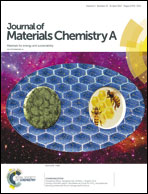Constructing a novel strategy for carbon-doped TiO2 multiple-phase nanocomposites toward superior electrochemical performance for lithium ion batteries and the hydrogen evolution reaction†
Abstract
The key issue for TiO2 as an anode in lithium ion batteries (LIBs) is improving its electronic conductivity and ionic diffusion ability, which hinder its rate performance and practical application in LIBs. Herein, we design a novel strategy using incompletely oxidized TiC as a precursor to prepare carbon-doped TiO2 multiple-phase nanocomposites with improved ionic and electronic conductivity. The as-prepared carbon-doped TiO2 multiple-phase (TiO2(B) and anatase as major phases; TiC as a minor phase) nanocomposites exhibit a superior rate performance of up to 142 mA h g−1 at 15 000 mA g−1 (∼45 C) as well as excellent cycling stability as anode materials in lithium-ion batteries, showing great potential for application in lithium-ion batteries. Through a combination of carbon doping and the introduction of multiple-phases, not only is the electrochemical performance greatly enhanced in lithium ion batteries, but this carbon-doped TiO2 nanocomposite also shows high activity and stability for the electrochemical hydrogen evolution reaction from water.



 Please wait while we load your content...
Please wait while we load your content...